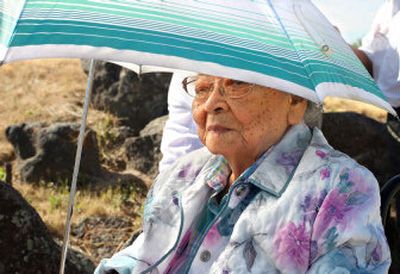WWII detainees revisit camp

HUNT, Idaho – Tomi Okano was six years old when she and her family were forced by the federal government to leave their Oregon home in 1942 and sent to a World War II detention camp for Japanese Americans in the southern Idaho desert.
More than 60 years later, she has few vivid memories of this place, save one.
“I remember the fence,” Okano said Saturday as she walked past the remnants of an entry checkpoint to the former 33,000-acre Minidoka Relocation Center compound. “I remember thinking, ‘If I could just go over that fence and over those mountains, there would be the ocean and I would be home.’ “
Okano, of Seattle, was one of about 100 former detainees and their families who made a pilgrimage from Seattle and Portland to the Idaho camp now designated the Minidoka Internment National Monument. The National Park Service hosted the visit to discuss with former internees its plans to develop a 73-acre parcel set aside in 2001 by President Clinton into an educational exhibit focusing on civil rights and the wartime experience of Japanese Americans.
Minidoka was one of 10 detention camps operated between 1942 and 1946 by the federal government in the western U.S. and Arkansas. The camps held thousands of West Coast residents who were deemed a security risk because they had at least 1/16 Japanese ancestry. The forced removal of Japanese Americans from the coastal “military exclusion area” was ordered by President Franklin Roosevelt two months after the Japanese navy’s Dec. 7, 1941, surprise attack on the U.S. fleet’s Pearl Harbor base.
Minidoka residents lived in dozens of tarpaper-covered barracks and worked on irrigation projects and farms. Today, only a handful of original structures remain.
“This was the site of some very dark days in our nation’s history,” Sen. Mike Crapo, R-Idaho, said. “The incarceration of almost 10,000 Japanese American citizens here at Minidoka represents a blight on the otherwise bright record of respect for human rights that our nation strives to uphold and promote.”
The Park Service’s new management plan for Minidoka released in June recommends Congress remove the word “internment” from the monument title because the agency says it means imprisonment of enemy aliens during wartime and does not accurately describe the government’s detention of U.S. citizens simply because of their ancestry.
It also proposes converting a still-standing camp warehouse into a visitor center, reconstructing military guard towers, and restoring barracks to authentically replicate the incarceration conditions at the camp. The agency is working with various historical societies to preserve the memories of the surviving Minidoka detainees, a task complicated by a cultural inclination to remain silent about the experience.
“Dad never talked about it,” said Larry Matsuda, a Seattle University professor who was born at Minidoka in 1945. “That was the noble thing to do.”